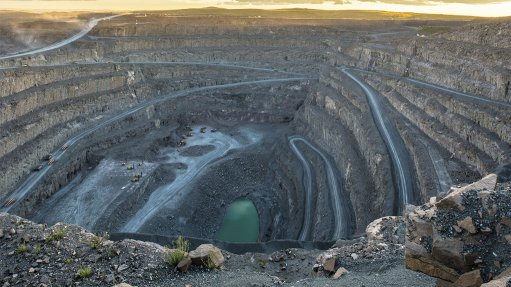Retreating discovery rates and exploration budget cuts to impact industry from 2016
TORONTO (miningweekly.com) – Retreating discovery rates and reduced exploration activity will impact global gold output from 2016 onward.
Financial information firm SNL Financial director for the metals and mining database Glen Jones this week said in the low-price environment, discovery rates were exacerbated by budget cutbacks, socio- and geopolitical risk and financing constraints.
“Current activity is a warning of future scarcity. We will feel the effects of what’s going on right now in the next five to ten years,” he forecast.
In a presentation during the Cambridge House International Vancouver Resource Investment Conference 2015, Jones noted that while gold output reached a peak in 2008, after 2016, output would start declining, owing to fewer ounces being discovered and longer timeframes to move new discoveries through to production.
In 2013, global gold output was about 84.2-million ounces of gold, 55%, or 46.3-million, of which majors accounted for.
This total was expected to rise through to 2016, as a result of current late-stage projects coming on stream, but after that, Jones pointed out, the market was staring down a looming supply deficit.
RESERVE REPLACEMENT
Discovery is the only way of securing new reserves, Jones stressed, noting that brownfield exploration around existing mines would not be enough to replace what had been taken out of the ground.
However, exploration budgets had, in recent years, dwindled from their 2012 peak.
Jones noted that exploration outlays peaked at around $21.5-billion in 2012 and fell 29% to $15.2-billion in 2013, and by about a further 47% to $11.4-billion in 2014. This was a dramatic decrease and was much more rapid than the rise in exploration budgets seen from 2009 to 2012.
Gold was by far still the metal most explored for and had an inverse relationship with copper exploration.
Jones explained that the budget-to-revenue percentage of gold miners peaked between 1995 and 1997, when the majors spent about 4% of their total budgets on exploration. Then in 2003/04, that percentage dropped to about 1.5%, when the majors altered their philosophy to allow juniors to undertake exploration so that majors could buy the projects later.
However, up to 2012, budget cutbacks and financial woes were again forcing companies to cut back on exploration dollars.
Jones said junior exploration dollars peaked in 2007, before starting a gradual retreat that again signalled a trend change that the majors were once more starting to increase their exploration budgets, as the juniors struggled with financing issues.
“From 2008 to 2014, the equity raised by juniors matched their exploration budgets, but by 2011, things started to [become] unhinged. In 2014, exploration recovered somewhat, but to nowhere near what it was in the past,” he highlighted.
FEWER FINDS
Jones said grass roots exploration budgets, which were where new discoveries came from, had decreased to about 32% of the total exploration budget, down from 42% previously. This discrepancy was being picked up by increased brownfield exploration, as companies regarded it as safer.
Late-stage exploration had also taken a knock in recent months, he noted.
Major mining areas such as Canada, the US, Mexico and Australia had seen significant exploration investments, while exploration efforts were less pronounced in jurisdictions deemed high-risk.
Jones pointed out that since the third quarter last year there had been an uptick in exploration investment and he hoped that this trend would continue into 2015. This drilling was not really being focused on new discoveries, but on resource extensions and around existing mine sites.
The number of initial resource announcements had also decreased significantly.
Jones underlined that fewer ounces would be available in the future. He said the cumulative potential for late-stage projects currently in the feasibility phase had the potential to produce up to about 22.4-million ounces a year when they came on stream.
However, when the projects located in high-risk jurisdictions were taken away, the number of ounces a year shrank about 17% to 18.7-million ounces. Further, if lower-grade projects were also removed from the pipeline, owing to a possible lower gold price, the potential future gold output fell by about 60% to only nine-million ounces a year.
According to Jones, the maximum potential global gold output in the past three years was about 1.2-billion ounces. In this period, only about 700-million new ounces were discovered and, when using a 75% resources-to-reserves conversion rate, and an average of 90% mill recovery, these discoveries were only going to replace 50% of what had been mined in the period.
“However, today only about 34% of the gold in these discoveries had been converted to reserves and many of these discoveries are low grade and some are located in high-risk areas, so, the real amount that’s going to be available might in fact be much less,” he advised.
LONGER LEAD TIMES
Jones pointed out that between 1999 and 2013 about 217 deposits were discovered, containing about 1.66-billion ounces. The world produced in this time 1.76-billion ounces, resulting in a ten-million-ounce deficit. If this trend continued, he warned, the industry would certainly be in trouble.
Grades of the top-five mining companies had decreased with the declining gold price, in tandem with rising costs. Many companies had also lowered their reserve calculation price, resulting in reducing residual values.
The average margin gold companies made had also declined to about 16% in 2013 and Jones expected the average margin an ounce for 2014 to be much less.
Jones argued that should there not be any new gold discoveries made in the future, the world’s current gold companies had in total about 18 years of future production left before all known reserves would be depleted.
Research had found that the time required to take a deposit discovery to a producing mine had also increased significantly. From 1994 to about 2003, the average time from discovery to production took about ten years, during which 48 mines went into production. In the next decade 126 mines took on average 17 years to achieve production, while future operations could take more than 20 years to get to production.
Comments
Press Office
Announcements
What's On
Subscribe to improve your user experience...
Option 1 (equivalent of R125 a month):
Receive a weekly copy of Creamer Media's Engineering News & Mining Weekly magazine
(print copy for those in South Africa and e-magazine for those outside of South Africa)
Receive daily email newsletters
Access to full search results
Access archive of magazine back copies
Access to Projects in Progress
Access to ONE Research Report of your choice in PDF format
Option 2 (equivalent of R375 a month):
All benefits from Option 1
PLUS
Access to Creamer Media's Research Channel Africa for ALL Research Reports, in PDF format, on various industrial and mining sectors
including Electricity; Water; Energy Transition; Hydrogen; Roads, Rail and Ports; Coal; Gold; Platinum; Battery Metals; etc.
Already a subscriber?
Forgotten your password?
Receive weekly copy of Creamer Media's Engineering News & Mining Weekly magazine (print copy for those in South Africa and e-magazine for those outside of South Africa)
➕
Recieve daily email newsletters
➕
Access to full search results
➕
Access archive of magazine back copies
➕
Access to Projects in Progress
➕
Access to ONE Research Report of your choice in PDF format
RESEARCH CHANNEL AFRICA
R4500 (equivalent of R375 a month)
SUBSCRIBEAll benefits from Option 1
➕
Access to Creamer Media's Research Channel Africa for ALL Research Reports on various industrial and mining sectors, in PDF format, including on:
Electricity
➕
Water
➕
Energy Transition
➕
Hydrogen
➕
Roads, Rail and Ports
➕
Coal
➕
Gold
➕
Platinum
➕
Battery Metals
➕
etc.
Receive all benefits from Option 1 or Option 2 delivered to numerous people at your company
➕
Multiple User names and Passwords for simultaneous log-ins
➕
Intranet integration access to all in your organisation




















